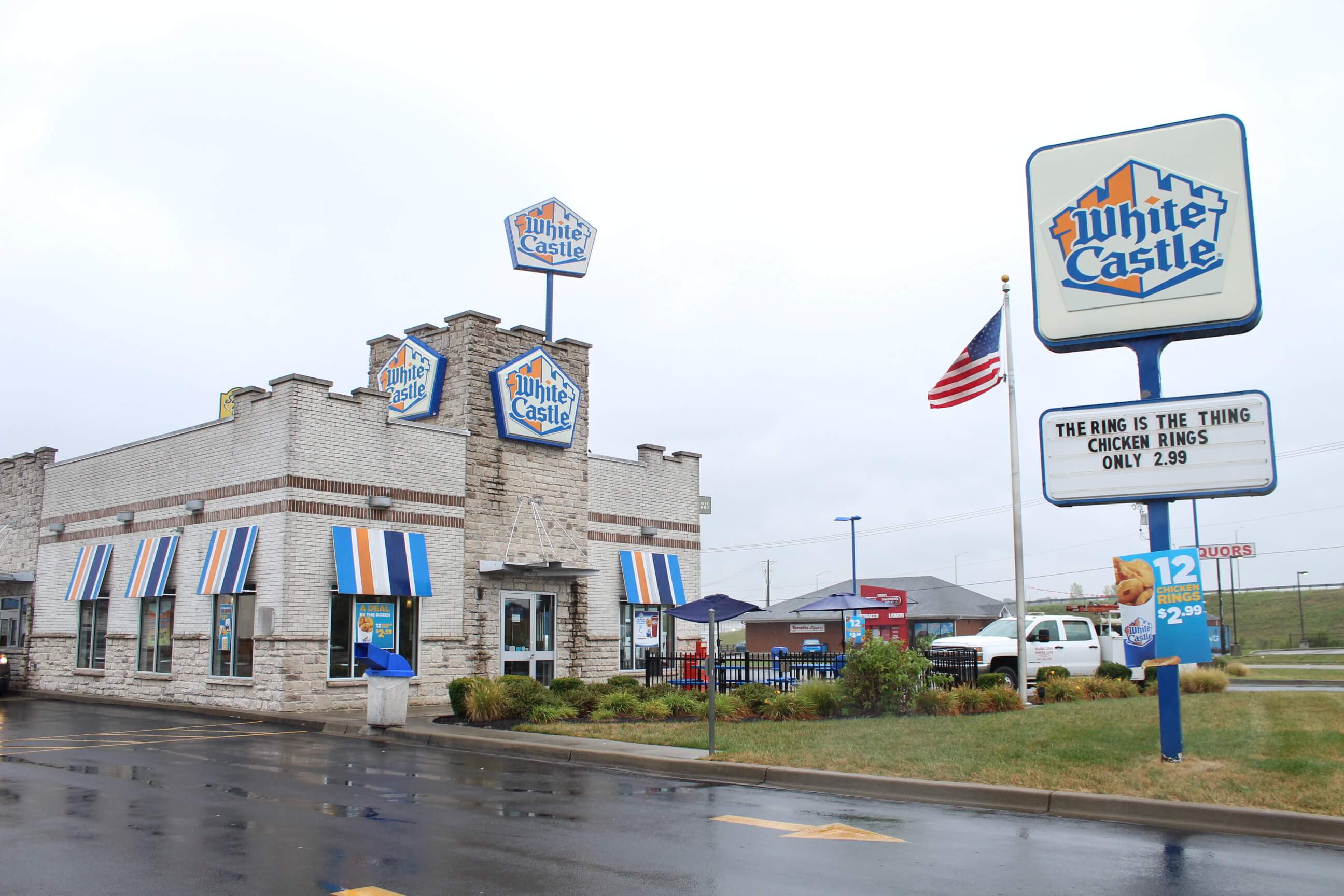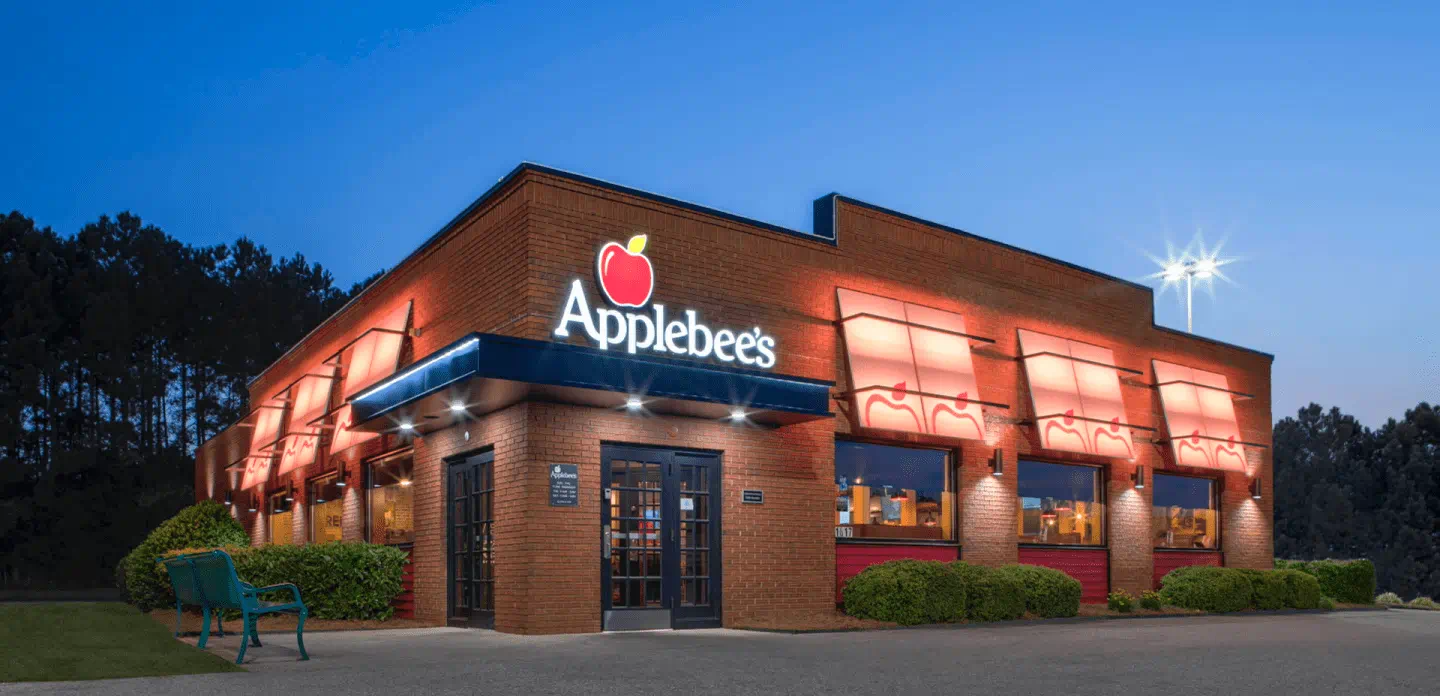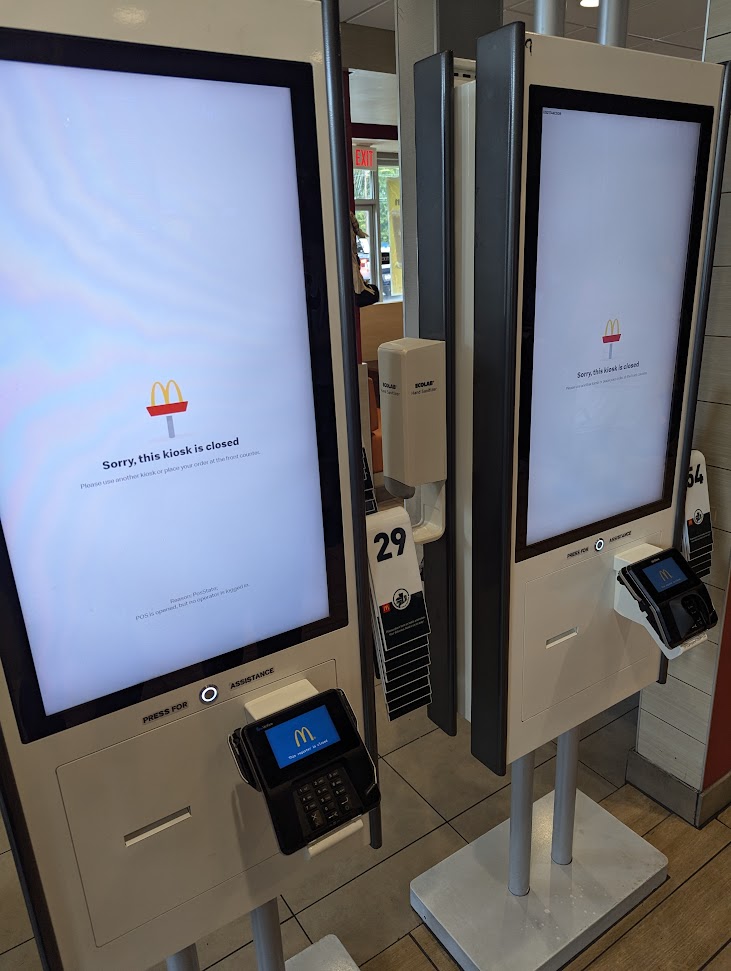11 QSR Chains Using AI Drive-Thru Technology (and What Could Go Wrong)
Wendy's, White Castle, Taco Bell, and 8 other QSR chains are testing AI drive-thru systems. Learn which restaurants use AI ordering and what problems customers are experiencing.
.jpeg)
When you pull up to a drive-thru today, there’s a good chance the voice taking your order is a robot:
AI.
Many [[quick-service restaurants]] (QSR) are turning to AI-powered ordering assistants that can capture and process orders faster and more consistently than employees balancing a headset, a payment terminal, and a fryer timer. The hope is that automation can ease the pressure on understaffed crews and keep lines moving. For QSRs, shifting order taking to AI could mean customers get their food faster and restaurants lower their service costs, all while keeping interactions smooth and accurate. Bonus points should AI be able to increase total order size too.
These are the aims of AI drive-thru. McDonald’s started testing AI drive-thru systems only a few years ago, and a handful of national chains have since followed suit. Our Fast-Food Friction survey found that, as of mid-2025, about 15% of QSR customers had tried an AI-powered drive-thru. Of that group, two-thirds said the experience was as good or better than ordering from a person, a strong showing for a technology still in its early phase.
The rollout of AI drive-thru has been in the works for some time and for good reason. The technology still has flaws, and flaws mean problems. For example, should an AI system botch an order or crash mid-transaction, customers notice in the worst possible way. While customers may tolerate (and forgive) human errors for all sorts of reasons, a higher expectation is placed on technology, especially if the tech is perceived as benefiting the business more than the customer.
How fast-food restaurants manage AI drive-thru technology so that customers love it is still very much a work in progress.
What Restaurants Use AI Drive-Thrus?
Each brand is taking its own approach to AI but with the common goals of easing staffing shortages and streamlining operations.
So, which QSR chains are exploring AI drive-thru systems, and what do those rollouts look like? Here’s what we know.

1. Wendy’s
Wendy’s is expanding its FreshAi system, built with Google, from roughly 100 locations to between 500 and 600 by the end of 2025. The system is designed to improve order accuracy and keep cars moving faster through the lane. Customer acceptance is still up for debate, with one Reddit user noting, “the AI order system is bad enough to where I drive to a further different Wendy’s now.”

2. White Castle
White Castle has partnered with SoundHound to deploy voice AI in about 100 of its drive-thrus, roughly 30% of the chain’s footprint. The system, called Julia, has sped up service and created a more consistent ordering experience. It’s also a key feature of the brand’s Castle of Tomorrow prototype, which includes a robotic fryer named Flippy and a dedicated mobile pickup spot. White Castle continues to stand out for its willingness to test new automation tools, including recent experiments with robot food delivery.

3. Checkers & Rally’s
Checkers and Rally’s are using Hi Auto to support Spanish-language voice ordering. After early success, the rollout now includes about 350 locations. The company says the AI shortens order times and improves upsell performance. Customers have also been accepting of the technology in testing, as they’re still met at the pickup window by a human who can double-check the order.
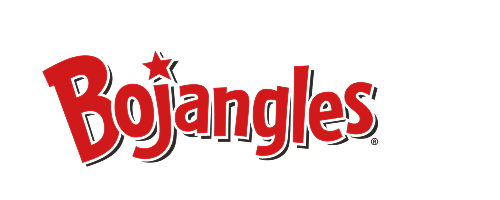
4. Bojangles
Bojangles’ voice bot, nicknamed Bo-Linda, has been so successful that the company is expanding it to hundreds of restaurants. Employees say the bot reduces their workload, allowing them to focus on food preparation and customer interaction instead of juggling the order line. But some customers don’t always notice the same benefits. One diner described the drive-thru line as “extra slow,” while another said it was so inefficient they ended up leaving.

5. Taco Bell
Taco Bell’s tests are part of Yum! Brands’ larger AI initiatives but have produced mixed results. Some customers praise the speed, while others have gone viral for catching system glitches. One customer ordered 18,000 water cups in an attempt to bypass the technology and reach a person. The company plans to refine the system as part of Yum’s broader 500-location rollout.

6. KFC
Also under the Yum! Brands umbrella, KFC is using Nvidia-powered AI to handle complex orders and speed up drive-thru operations. Early tests focus on accuracy and throughput in high-traffic markets. The long-term goal is a fully digital ordering experience, though some failures signal that reality may still be distant.

7. Pizza Hut
Pizza Hut is testing AI drive-thrus alongside Taco Bell and KFC as part of Yum’s initiative to create a unified ordering experience across all of its brands using the same core technology. The effort builds on Pizza Hut’s broader push to use digital tools to strengthen loyalty, including self-service kiosks that simplify ordering.

8. Church’s Chicken
Church’s Chicken (a.k.a. Church's Texas Chicken) is piloting SoundHound AI systems that let customers place orders with a voice assistant while still giving staff the option to step in when needed. Early reports show shorter wait times and smoother handoffs between humans and machines.

9. Carl’s Jr. and Hardee’s
The two CKE brands are working with Presto Voice to automate drive-thru ordering across hundreds of locations. CKE reports a 6% sales lift tied to more consistent upselling, though some customers question whether they’re seeing much benefit themselves.

10. Del Taco
Del Taco is also working with Presto. The company began with small pilots, then expanded after reporting that the AI exceeded expectations for accuracy and speed. One customer was so pleasantly surprised that AI got his order right that he posted a photo of his receipt as proof. Broader deployment is planned across roughly 600 restaurants.

11. Panda Express
Panda Express, another SoundHound partner, has added AI drive-thrus at about 30 locations to improve efficiency, though some customers say they couldn’t complete an order until a human took over.
... and more AI drive-thrus to come
As more restaurants experiment with AI drive-thru rollouts, we’ll update this post. Subscribe by email to get our quarterly newsletter in which we cover the latest in restaurant technology and other connected products:
Do you live on the edge of endpoint management?
Discover how global brands and businesses manage their connected product ecosystems. Get the inside-scoop from the hidden architects and teams who ensure their remote devices never go down.
Subscribe to the Canopy Insights newsletter.

Do you live on the edge of endpoint management?
Discover how global brands and businesses manage their connected product ecosystems. Get the inside-scoop from the hidden architects and teams who ensure their remote devices never go down.
Subscribe to the Canopy Insights newsletter.

Do you live on the edge of endpoint management?
Discover how global brands and businesses manage their connected product ecosystems. Get the inside-scoop from the hidden architects and teams who ensure their remote devices never go down.
Subscribe to the Canopy Insights newsletter.
With so many pilots underway, most brands are still learning what works (and what doesn’t) as they go. Technical teams and partners (like Soundhound) continue to refine voice models while relying on employee oversight to catch errors before customers notice. Years from now, AI drive-thru may be the norm, but a lot still has to be fixed before the tech becomes widespread.
What Could Go Wrong With AI Drive-Thru?
AI drive-thru systems depend on many components passing information back and forth without delay. Componentry like microphones and headsets are simple enough but stacked alongside network connections, point-of-sale systems, kitchen displays, and the AI model itself … things get complicated. When even one of those elements fails, the customer experience can unravel.
Of course, training the AI is another factor. Most systems are designed to process speech at a normal conversational pace and interpret words exactly as they appear on the menu. That can cause problems when customers talk quickly, use unfamiliar descriptions, or change their minds mid-order. If someone says, “a Big Mac with no pickles… actually, extra pickles,” the system often fails to register the correction.
These issues slow down service and add pressure for staff who have to step in and fix the problem. And because drive-thru and takeout orders make up most QSR sales, the impact goes beyond operational delays. Technical failures and the loss of customer trust that follows can both carry real financial consequences.
.png)
5 AI Drive-Thru Problems
Our survey found several recurring issues that leave customers dissatisfied with AI drive-thrus.
1. AI Misunderstood My Order
Three out of four customers said the AI didn’t capture their order correctly. McDonald’s is the most well-known example with many reports of errors, like incorrect totals and repeated miscalculations. The abundance of problems led the QSR giant to end the program.
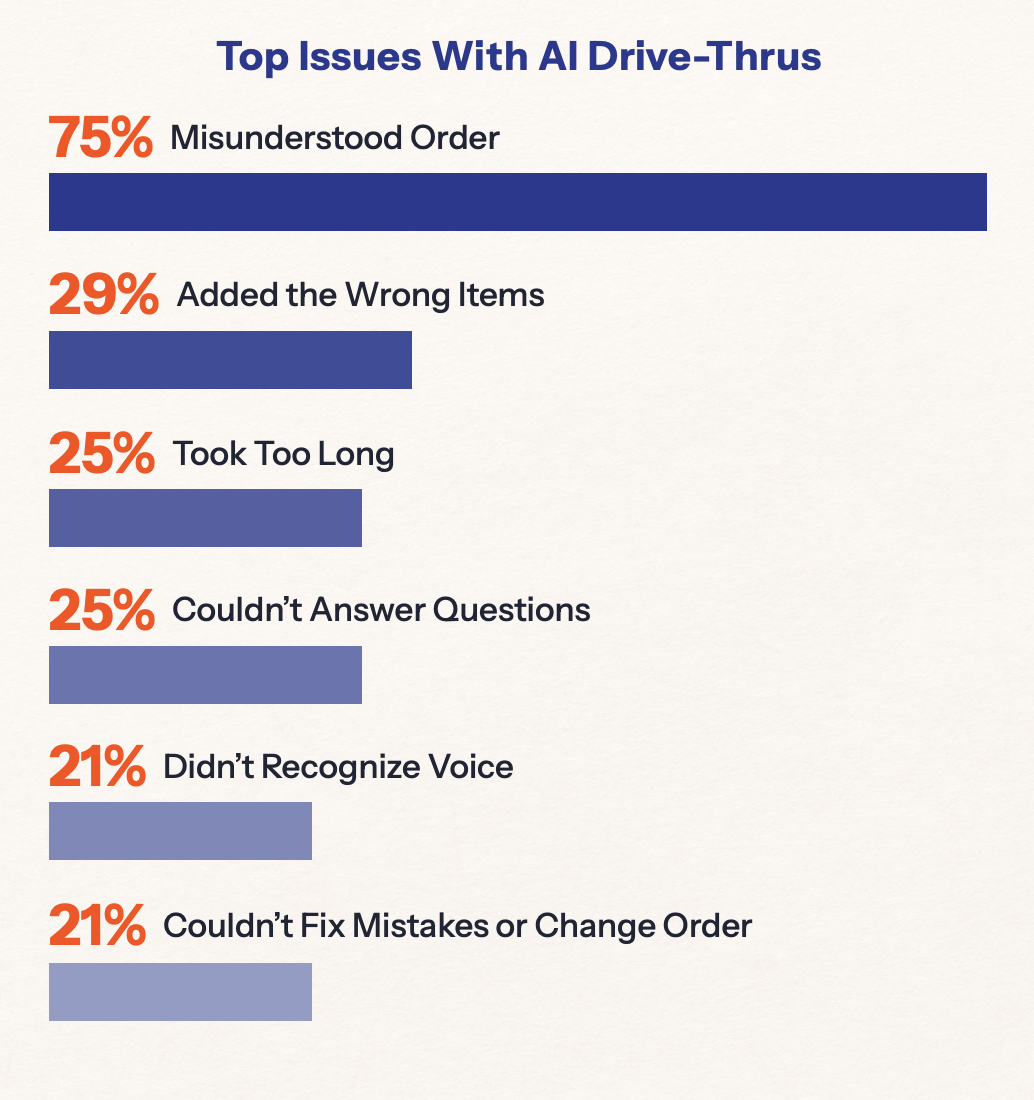
2. My AI Order Took Too Long
One in four customers said their AI-assisted order took longer than expected. Many shared experiences where the technology slowed things down, even as brands report improved service times overall.
3. AI Tried to Upsell Me
In open-ended feedback, customers said AI systems often tried to upsell them, which felt pushy and robotic, all while adding time to the experience that the customer didn’t care to give. While “Would you like fries with that?” is part of the classic QSR script, customers lose patience when a machine keeps pushing after they’ve already said no.
4. AI Couldn’t Answer My Questions
One in four customers said the system couldn’t respond to basic menu questions. The issue becomes more frustrating when the AI promotes an item but can’t answer simple follow-ups, creating friction instead of convenience.
5. AI Didn’t Recognize My Voice
About one in five customers said the AI didn’t recognize their voice, forcing them to repeat themselves or start over. The problem is compounded when speech patterns, slang, or accents fall outside what the model was trained to understand.
All of these issues erode trust and patience, but the most damaging scenario is when the system goes down entirely. As fast-food restaurants integrate technologies like AI drive-thrus, they need reliable tools to monitor, detect, and resolve issues before they affect customers.
New Technology Requires a Strong Foundation
As with all restaurant technology, reliability is what keeps the system up and running, and in the case of the drive-thru line, the customers rolling. Solving for reliability with increasingly complicated and complex restaurant technology stacks is where [[remote monitoring and management]] (RMM) is most helpful.
RMM platforms can be used as the foundation upon which every technology within a restaurant can be connected, monitored, managed, and even automated. So whether it’s the AI drive-thru or the kitchen display systems, the self-service kiosks or the fryers and refrigeration, all the remote device technology is kept up-to-date. Firmware is updated. Software is configured to spec. Devices and be powercycled as needed. Metrics can be custom-tailored and passed along to other systems. On and on, RMM can be the universal remote that ensures all the technology just works. And should tech need attention, technical support teams are notified smartly and can execute fixes before customers ever notice (even automatically).
AI drive-thrus are here today and are looking to become even more common tomorrow. But how this technology gets managed so that customers get the experience they expect is yet to be seen.



